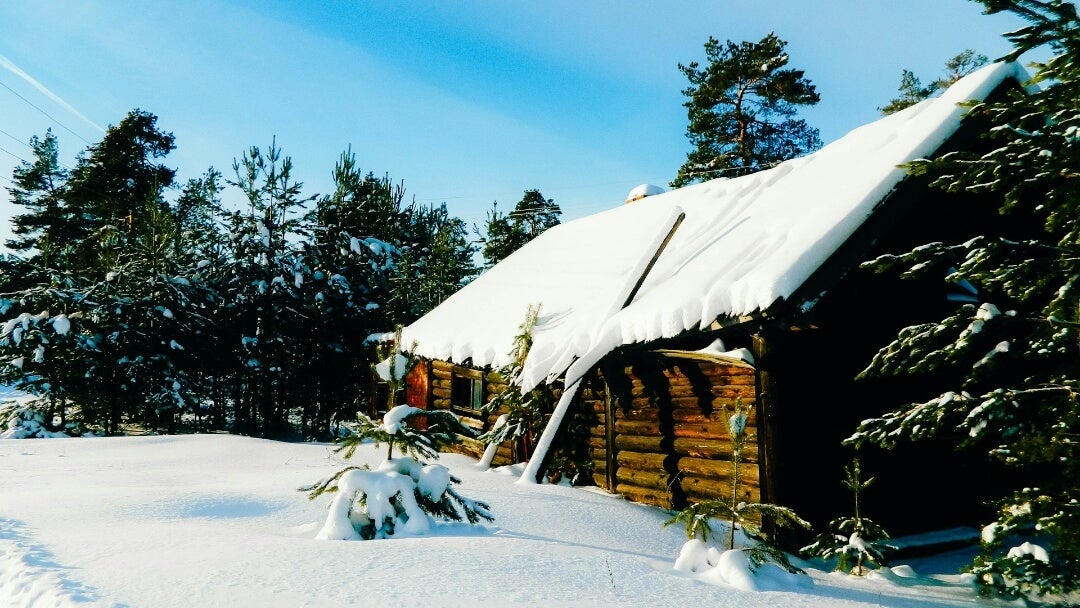Fend Off the Coming Frost with 6 Innovative Homestead Heating Options
Martin Banks 09.17.24

Staying warm matters, especially after coming in from a day of hunting in the cold. Fortunately, there are scores of ways to heat your homestead, many of which require no connection to the grid. Most require little more than good, old-fashioned common sense and a small upfront investment. What’s the right option for your needs? Here are six toasty innovations to consider for your homestead heating in the colder months of the year.
1. Insulate – Homestead Heating
Any homestead heating option you choose will work better in a well-insulated cabin. When was the last time you performed an energy audit? You might not have as many steps in a tiny off-grid hunting shack as you do at home, but the time you spend could save you a bundle. Here’s what to do:
- Inspect your doors and windows: Do they need caulk or weather stripping? Check to see if you feel a draft, or use a thermometer to detect temperature changes. Are there any cracked windows you can replace with heavier dual-pane models? Thick, heavy curtains also do a decent job of blocking cold and heat — if your windows are undressed, consider covering them.
- Inspect your insulation: Look for signs of wear or areas where it’s missing altogether, and add more where necessary. Do your pipes a favor and wrap them, too, especially if your homestead sits unused during the coldest part of the year.
Of course, if your homestead has any obvious openings to the outside, like a hole in the roof, you should address that before implementing other solutions. You want your cabin snug and closed up tightly against the elements.
2. Geothermal Tubes – Homestead Heating
Did you know that the temperature beneath the earth is a constant 55 degrees Fahrenheit regardless of outside weather? A geothermal loop system could heat your off-grid homestead. Geothermal ground loop systems take advantage of the thermal energy under your lawn.
Also known as ground source heat pumps, geothermal loops are the primary heating method used in Iceland — they’re reliable and last for years without repairs or replacement. However, you may need a professional to survey your property to determine its suitability for such a system and run the initial installation.
3. Propane Heaters – Homestead Heating
Propane heaters come in portable or fixed models, depending on the size of your homestead. However, indoor models should come equipped with an oxygen depletion sensor to prevent carbon monoxide issues and protect your health.
You can find propane wall heaters designed for indoor use and DIY installation. Additionally, many mini-split units work well with that larger propane tank in your yard — they’re excellent options if you battle both heat and cold.
4. Wood Stoves – Homestead Heating
Wood stoves are another option for heating your homestead. You can build a simple model with little more than tin cans, snips and a tea light candle, although you won’t radiate enough to warm a large room, let alone an entire cabin. You’re better off opting for a professional model intended for indoor use.
Wood stoves can release particulates and create soot. Pellet stoves are another alternative that produces less emissions and ash but don’t have quite the heating power of traditional wood models.
5. Sun Power – Homestead Heating
Solar panels are an obvious way to harness the sun’s rays to heat your home. However, you might also harness the power of passive solar. It’s a bit tricky if your homestead lies under tall trees that block much of the available light. However, those with sunny windows can remove or tie back those trusty curtains during daylight hours to let the radiation warm their cabin’s interior.
The big advantage of a full solar setup is that it provides sufficient power to run electrical appliances. This factor matters if your homestead is far from the nearest power lines.
6. A Trusty Furnace – Homestead Heating
Assuming you have power, a regular furnace may be your best homestead heating bet. Unlike wood and pellet stoves, it doesn’t produce a residue. Plus, some models feature more than 98% efficiency, minimizing heat loss. Finally, you can heat every room evenly, a huge bonus if you have more than a one-room hunting cabin.
If you go this route, maintain your system. For example, you should change your air filter every 60-90 days, but use your judgment. Conditions like indoor smoking, heavy dust and pet dander can quickly lead to buildup that affects your efficiency.
Another advantage of a furnace, unlike a wood stove or propane, is that you can leave it running on low in your absence. Doing so protects your plumbing if your homestead lies in an area that sees frequent freezing temperatures, especially if you don’t reside there full-time. Plus, there’s much less work necessary to get warm when coming in from the cold.
Homestead Heating Options
You have multiple options for keeping your homestead cozy in winter. Choose the option that works best for your needs and stay snug all winter long, even in subzero conditions.
